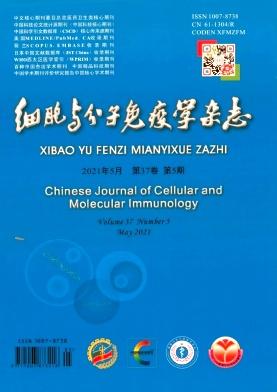[LncRNA EFRL对同型半胱氨酸诱导的巨噬细胞efferocytosis动脉粥样硬化的影响及机制]。
摘要
目的探讨Efferocytosis相关LncRNA (EFRL)在同型半胱氨酸诱导的巨噬细胞Efferocytosis动脉粥样硬化中的作用及机制。方法体外培养RAW264.7细胞,设对照组(0 μmol/L Hcy)和Hcy干预组(100 μmol/L Hcy)。Hcy干预巨噬细胞转染GapmeR后,建立EFRL敲低阴性对照组(Hcy联合LNA-NC)和EFRL敲低组(Hcy联合LNA-EFRL)。采用高通量测序对LncRNA MSTRG的不同表达进行检测。88917.16 (EFRL), UCSC分析其保守性,CPC和CPAT分析其编码蛋白质的能力,GO和KEGG分析其相关生物学功能。通过核质分离和RNA-FISH分析LncRNA EFRL在巨噬细胞中的定位。采用实时荧光定量PCR检测LncRNA EFRL及其靶基因SPAST在hcy处理巨噬细胞中的表达水平。用流式细胞术检测紫外线诱导Jurkat细胞凋亡率。采用体外efferocytosis法联合免疫荧光技术分析巨噬细胞efferocytosis。ELISA法检测血清白细胞介素1β(IL-1β)和IL-18水平。结果鉴定出新的LncRNA MSTRG.88917.16,并命名为Efferocytosis related LncRNA (EFRL)。UCSC、CPC和CPAT分析表明LncEFRL是高度保守的,不具有编码蛋白质的能力。GO和KEGG分析提示LncEFRL可能参与巨噬细胞efferocytosis。通过核质分离和RNA-FISH检测,LncRNA EFRL定位于巨噬细胞的细胞核中。与对照组相比,Hcy组LncRNA EFRL及其靶基因SPAST的表达水平升高。与对照组(0 min)相比,实验组(15、30 min) Annexin V的凋亡率均大于85%。与Hcy联用LNA-NC组比较,Hcy联用LNA-EFRL组巨噬细胞effocytic增强,炎症因子水平降低。与Hcy联合LNA-NC组相比,Hcy联合LNA-EFRL组SPAST的表达水平降低。结论抑制EFRL表达可缓解Hcy抑制巨噬细胞efferocytosis的过程,其机制与EFRL调控下游靶基因SPAST有关。Objective To investigate the effect and mechanism of Efferocytosis Relatived LncRNA (EFRL) on homocysteine-induced atherosclerosis in macrophage efferocytosis. Methods RAW264.7 cells were cultured in vitro, and the Control group (0 μmol/L Hcy) and Hcy intervention group (100 μmol/L Hcy) were set up. After GapmeR transfection of macrophages with Hcy intervention, EFRL knockdown negative control group (Hcy combined with LNA-NC) and EFRL knockdown group (Hcy combined with LNA-EFRL) were set up. High-throughput sequencing was applied for different expression of LncRNA MSTRG. 88917.16 (EFRL), UCSC was used to analyze its conservation, CPC and CPAT were used to analyze its ability to encode proteins, and GO and KEGG were used to analyze related biological functions. The localization of LncRNA EFRL in macrophages was analyzed by nucleoplasmic separation and RNA-FISH. Quantitative real-time PCR was used to detect the expression levels of LncRNA EFRL and its target gene SPAST in Hcy-treated macrophages. The apoptosis rate of Jurkat cells induced by UV was detected by flow cytometry. In vitro efferocytosis assay combined with immunofluorescence technique was used to analyze macrophage efferocytosis. ELISA was used to detect the levels of interleukin 1β(IL-1β) and IL-18. Results The new LncRNA MSTRG.88917.16 was identified and named EFRL(Efferocytosis Relatived LncRNA). UCSC, CPC and CPAT analyses showed that LncEFRL is highly conserved and does not have the ability to encode proteins. GO and KEGG analyses suggested that LncEFRL may be involved in macrophage efferocytosis. LncRNA EFRL was localized in the nucleus of macrophages as determined by nucleoplasmic separation and RNA-FISH. In comparison to the Control group, the expression levels of LncRNA EFRL and its target gene SPAST in the Hcy group were increased. In comparison to the Control group (0 min), the apoptosis rate of the experimental group (15, 30 min) Annexin V is more than 85%. Compared with Hcy combined with LNA-NC group, Hcy combined with LNA-EFRL group had enhanced macrophage efferocytosis and reduced levels of inflammatory factors. Compared with Hcy combined with LNA-NC group, the expression level of SPAST in Hcy combined with LNA-EFRL group was decreased. Conclusion Inhibition of EFRL expression can alleviate the process of Hcy inhibiting macrophage efferocytosis, and the mechanism is related to the regulation of the downstream target gene SPAST by EFRL.

 求助内容:
求助内容: 应助结果提醒方式:
应助结果提醒方式:


